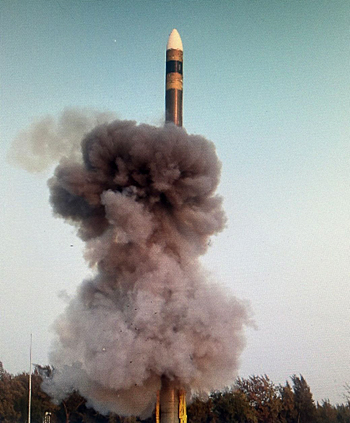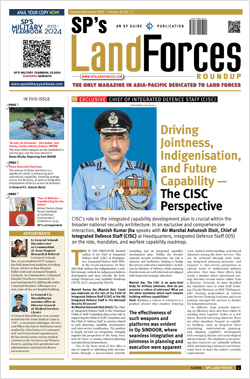INDIAN ARMED FORCES CHIEFS ON OUR RELENTLESS AND FOCUSED PUBLISHING EFFORTS

The insightful articles, inspiring narrations and analytical perspectives presented by the Editorial Team, establish an alluring connect with the reader. My compliments and best wishes to SP Guide Publications.

"Over the past 60 years, the growth of SP Guide Publications has mirrored the rising stature of Indian Navy. Its well-researched and informative magazines on Defence and Aerospace sector have served to shape an educated opinion of our military personnel, policy makers and the public alike. I wish SP's Publication team continued success, fair winds and following seas in all future endeavour!"

Since, its inception in 1964, SP Guide Publications has consistently demonstrated commitment to high-quality journalism in the aerospace and defence sectors, earning a well-deserved reputation as Asia's largest media house in this domain. I wish SP Guide Publications continued success in its pursuit of excellence.
- Appointments Committee of Cabinet approves one-month extension in service of Chief of the Army Staff
- Prime Minister witnesses 'Bharat Shakti' – a Tri-Services Firing and Manoeuvre Exercise in Pokhran, Rajasthan
- Interim Defence Budget 2024-25 — An Analysis
- Union Defence budget 2024
- Indian Army: In quest of greater firepower and policy recommendations for gaps
- Indian Army Annual Press Conference 2024
- Tata Boeing Aerospace Delivers 250 AH-64 Apache Fuselages, Manufactured in India
Agni-5 Ballistic Missile Tested
The successful test of the Agni-5 represents a major leap forward in India's ability to maintain a credible nuclear deterrent and strengthen its defence posture amidst an evolving regional and global security landscape
 |
The Author is Former Director General of Information Systems and A Special Forces Veteran, Indian Army |

On August 21, 2025, India successfully test-fired its Agni-5 long-range ballistic missile from the Integrated Test Range (ITR) at Chandipur, in Odisha. All the operational and technical parameters of the missile were validated in this successful test, as confirmed by the Ministry of Defence (MoD). The test marked a pivotal milestone in the nation's strategic defence progression, as well as, underscoring India's growing capabilities in advanced ballistic missile technology.
Developed by the Defence Research and Development Organisation (DRDO), the Agni-5 missile stands out as the most sophisticated missile in the Agni series, forming the backbone of India's land-based nuclear deterrent. With a striking range exceeding 5,000 km (about 3,000 miles), the Agni-5 is nuclear-capable and engineered to deliver a warhead weighing up to 1.5 tonnes, leveraging lightweight composite materials which heightens both reliability and efficiency.
Developed by the Defence Research and Development Organisation (DRDO), the Agni-5 missile stands out as the most sophisticated missile in the Agni series, forming the backbone of India's land-based nuclear deterrent.
The propulsion system of Agni-5 is based on a three-stage, solid-fuel design, allowing for reliable long-distance performance. A cannisterised launch platform enables rapid deployment, streamlined storage logistics, and heightened mobility, significantly enhancing operational flexibility and survivability in a conflict scenario. A hallmark feature of the Agni-5 missile is its integration of Multiple Independently Targetable Re-entry Vehicle (MIRV) technology. This advancement empowers a single missile to deliver multiple warheads on distinct targets, greatly multiplying the strategic effectiveness and survivability of India's deterrent arsenal.
For guidance and targeting precision, the Agni-5 employs state-of-the-art ring laser gyroscope-based inertial navigation system (RLG-INS), supplemented by a micro-inertial navigation system (MINGS). These systems are further augmented by satellite navigation aids such as India's indigenous NavIC and the US Global Positioning System (GPS), enabling the missile to achieve pinpoint accuracy during deployment.
A hallmark feature of the Agni-5 missile is its integration of Multiple Independently Targetable Re-entry Vehicle (MIRV) technology.
Recent upgrades to the missile include improvements in avionics, re-entry heat shielding, and advanced guidance systems, all of which reinforce the missile's capability to effectively deliver strategic payloads under varying operational parameters.The successful test of the Agni-5 represents a major leap forward in India's ability to maintain a credible nuclear deterrent and strengthen its defence posture amidst an evolving regional and global security landscape.
Some of the world's most prominent and high-performing missiles notable for their strategic importance, speed, or range include: Russia's RS-28 Sarmat three-stage, liquid-fuel missile with a range of 18,000 km and a launch weight of 208.1 tonnes: Russia's Avangard missile system having an intercontinental range exceeding 6,000 km, launched from a ballistic missile and carries a hypersonic glide vehicle capable of manoeuvring at speeds of Mach 20–27 to deliver nuclear or conventional payloads; China's DF-41 intercontinental ballistic missile (ICBM), displayed in 2019 is China's newest missile having a range of 12,000 to 15,000 km and capable of reaching targets in the United States mainland; America's Minuteman III (LGM-30G) intercontinental ballistic missile (ICBM) having a range of up to 14,000 km; French M-51 having an estimated operational range of 8,000 to 10,000 km - the M51's range varies depending on the specific version and configuration, with the M51.2 and M51.3 versions offering increased ranges compared to the earlier M51.1.
India's Agni-6 missile is under development and on track; details regarding its launcher have been revealed in 2023.
India's Agni-6 missile is under development and on track; details regarding its launcher have been revealed in 2023. The Agni-6 will be sleeker than the Agni-5. Where Agni-5 is capable of carrying 10 nuclear warheads, Agni-6 would perhaps be capable of launching more than 10 such warheads. With a range of 10,000 to 12,000 kms, Agni-6 will bring India into the top bracket of countries having such strategic reach.
Notably, India's test of the Agni-5 missile on August 21, 2025 was monitored by the US. The US Navy's USS 'Santa Barbara' was docked in Colombo to keep an eye on India - collecting telemetry data, like missile trajectory, velocity, and warhead performance for assessing India's BMD, SLBM capabilities and performance of the Agni-5. But that was not all. The US Air Force WC-135 (Nuclear Sniffer} was spotted flying in Pakistan's Exclusive Economic Zone (EEZ). With America's Donald Trump administration going anti-India and embracing Pakistan strategically, will the US try to sabotage India's missile programme, including the development of Agni-6?
The 2024 China Military Power Report by the US Department of Defense (DoD) highlights China's ongoing and significant expansion and modernisation of its nuclear forces, with particular focus on Intercontinental Ballistic Missiles (ICBMs).
The 2024 China Military Power Report by the US Department of Defense (DoD), released in December 2024, highlights China's ongoing and significant expansion and modernisation of its nuclear forces, with particular focus on Intercontinental Ballistic Missiles (ICBMs). The report indicates China has 550 ICBM launchers, 400 ICBMs, and has built approximately 320 new silos for solid-fuel ICBMs across three missile fields (Yumen, Hami, and Yulin). China is also increasing the number of silos for the liquid-fuel DF-5 ICBM and modernising the missile itself. These silos and improvements in early warning systems suggest a possible move towards a launch-on-warning (LOW) posture, allowing for a faster response to potential attacks. The report emphasises that all of China's ICBMs can target the continental United States. The report estimates that China's nuclear arsenal will surpass 1,000 warheads by 2030, with many deployed at higher readiness levels. At the same time, there are uncertainties surrounding the types and number of warheads each missile carries and whether China will need to increase plutonium production to meet the needs of its expanding nuclear stockpile.





